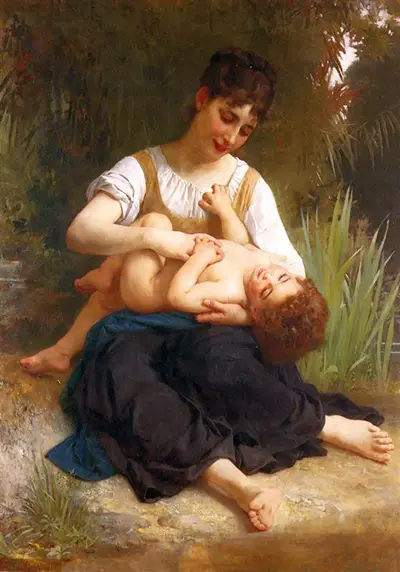 Buy Art Prints Now
Buy Art Prints Nowfrom Amazon
* As an Amazon Associate, and partner with Google Adsense and Ezoic, I earn from qualifying purchases.
William Bouguereau has long been considered one of the foremost French Academic artists. His work faithfully showcases that particular style of post-Renaissance painting which was taught in art schools, or 'academies' as they were known at that time.
Such paintings often featured mythological creatures and attempted to idealize human form and communicate intellectually and morally uplifting messages to the viewer. The canvas sought to have a polished quality with an absence of visible brushstrokes. This technique was also practiced by fellow Academic artists such as Thomas Couture, Delphin Enjolras, Gustave Courbet, and Hans Makart, to name, but a few.
Paintings of this period are typically, spectacularly beautiful and it is literally possible to lose oneself, gazing at the many different ones.
Adolphus Child and Teen is certainly no exception to this criteria. Painted in 1878, when Bouguereau was fifty-three years old, it portrays a teenage girl holding a bouncing, naked, cherubic baby of substantial proportion. They are sitting, perhaps by a riverbed near a wooded meadow and she is gazing lovingly down at him while he tugs at the neckline of her shirt and spiritedly lifts up one knee. It is a picture of pure sweetness and charm.
The use of the cherub, or putto, in Italian, was prolific even in earlier works of Renaissance art. So iconic were these little cupids or angels, that many, many artists were compelled to use them in their works to depict either innocent or erotic love. Two of the most famous Renaissance putto can be found at the foot of Raphael's Sistine Chapel Madonna. While effectively depicting the splendor and glory of the bond between Mary and the Christ child, it is the cherubs' mingled expressions of bridled curiosity and boredom about the entire spectacle that make the painting even more endearing.
Post-Renaissance, the naked babe or cherub was also favored by contemporaries of Bouguereau, other Academic artists such as Austrian Hans Makart in his work Abundantia, or Gifts of the Earth. This work depicts the female Abundantia representing fertility and abundance as symbolized by cherubs, baby animals and fruit. In keeping with the artistic ideals of the Academic period, Adolphus Child and Teen saw Bougeureau successfully capture in time a most infinite moment of tenderness between two young souls.




